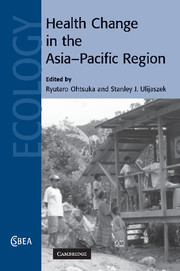Book contents
- Frontmatter
- Contents
- List of contributors
- Acknowledgements
- 1 Health change in the Asia-Pacific region: disparate end-points?
- 2 Interactions of nutrition, genetics and infectious disease in the Pacific: implications for prehistoric migrations
- 3 Biocultural adaptation and population connectedness in the Asia-Pacific region
- 4 Changing nutritional health in South East Asia
- 5 Obesity and nutritional health in Hong Kong Chinese people
- 6 Modernization, nutritional adaptability and health in Papua New Guinea Highlanders and Solomon Islanders
- 7 Tongan obesity: causes and consequences
- 8 Nutrition and health in modernizing Samoans: temporal trends and adaptive perspectives
- 9 Health patterns of Pacific Islanders and Asians in the United States
- 10 Impacts of modernization and transnationalism on nutritional health of Cook Islanders
- 11 Mortality decline in the Pacific: economic development and other explanations
- 12 Health changes in Papua New Guinea: from adaptation to double jeopardy?
- Index
- References
8 - Nutrition and health in modernizing Samoans: temporal trends and adaptive perspectives
Published online by Cambridge University Press: 15 September 2009
- Frontmatter
- Contents
- List of contributors
- Acknowledgements
- 1 Health change in the Asia-Pacific region: disparate end-points?
- 2 Interactions of nutrition, genetics and infectious disease in the Pacific: implications for prehistoric migrations
- 3 Biocultural adaptation and population connectedness in the Asia-Pacific region
- 4 Changing nutritional health in South East Asia
- 5 Obesity and nutritional health in Hong Kong Chinese people
- 6 Modernization, nutritional adaptability and health in Papua New Guinea Highlanders and Solomon Islanders
- 7 Tongan obesity: causes and consequences
- 8 Nutrition and health in modernizing Samoans: temporal trends and adaptive perspectives
- 9 Health patterns of Pacific Islanders and Asians in the United States
- 10 Impacts of modernization and transnationalism on nutritional health of Cook Islanders
- 11 Mortality decline in the Pacific: economic development and other explanations
- 12 Health changes in Papua New Guinea: from adaptation to double jeopardy?
- Index
- References
Summary
Introduction
In 1988, David Tua, a Samoan raised on the island of Upolu, stormed the world's heavyweight boxing circles. He is one of the many Samoans who have become known internationally for their athleticism, whether in the boxing ring, on the rugby field, in American football or in paddling traditional outrigger canoes. While such athletes train and remain fit, Samoan communities in the archipelago and abroad are experiencing the negative health effects of the nutrition transition. Shifts in diet and physical activities are leading to chronic positive energy balance and high prevalence rates of obesity and related non-communicable diseases (NCD). In 2003 in the nation of Samoa, about one-third of men and over half of women aged 25 to 74 years were obese by Polynesian standards for body mass index (BMI). In 2002, 100 km across the ocean in American Samoa, about 60% of men and almost three-quarters of women were obese by the same standard. Along with these marked levels of adulthood overweight and obesity, Samoan people suffer from high levels of cardiovascular disease, type 2 diabetes, and other associated metabolic disorders (McGarvey 2001; McGarvey et al. 2005). Recently there has been a distinct rise in childhood and adolescent obesity in Samoa (Roberts et al. 2004), which threatens to exacerbate NCDs at earlier ages in the future.
This chapter describes the putative causes and health consequences of the changes in nutritional status among Samoans in the early twenty-first century.
- Type
- Chapter
- Information
- Health Change in the Asia-Pacific Region , pp. 147 - 191Publisher: Cambridge University PressPrint publication year: 2007
References
- 38
- Cited by



